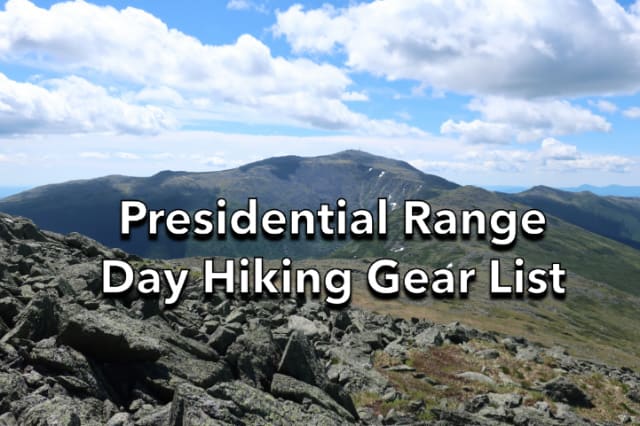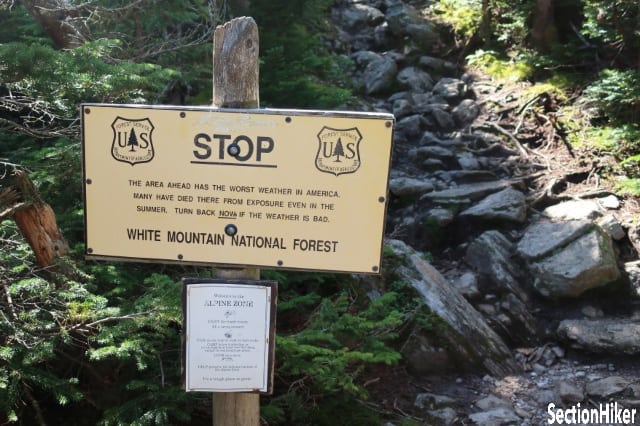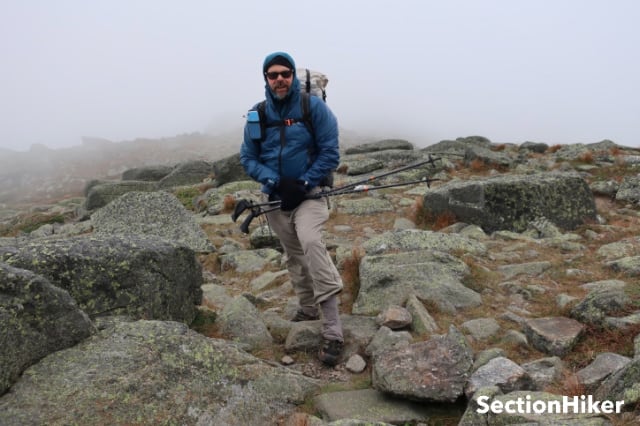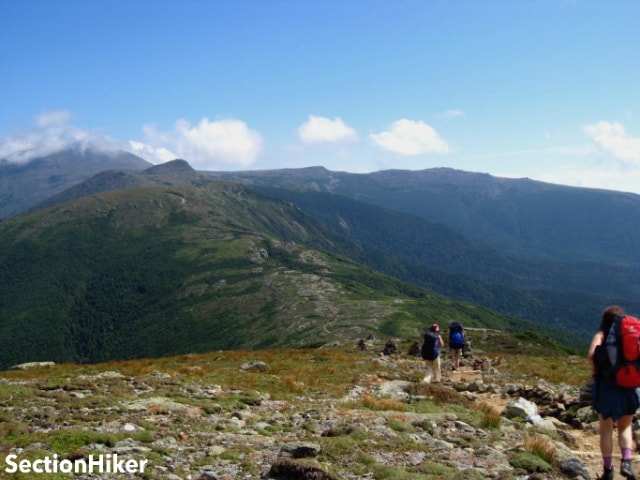
You need to be on your best game when you venture above treeline in the Presidential Range on Mt Washington and the higher peaks. Whether you’re hiking a Presidential Traverse or just climbing White Mountain 4000 footers, it pays to pack a little extra insulation and familiarize yourself with the trail network in case you need to get back down below treeline in a jiffy.
I’ve still had a few close calls in the Presidentials when I’ve been so scared I thought I was going to die. It might be sunny and clear one minute before the cloud ceiling drops and blankets the ridge in fog or a thunderstorm blows in and marble-sized hail falls all around you.

Here’s the day hiking gear I carry when I hike in the Presidential Range from June thru October when the snow has retreated enough to switch over to warmer weather clothing. Even then, the average temperature on Mt Washington, which is in the middle of the Presidential Range, ranges between 30 – 50 degrees with an average wind speed between 25 – 35 mph. Remember those are averages: some days are better and some days are worse. In addition, it snows every month of the year. On days when it’s too cold or too windy in the Presidential Range, we stay home or hike someplace else.
Navigation and Electronics
I’m always amazed when I meet people in the Presidentials and they ask me where they are because they’re not carrying a map. There are dozens of intersecting trails in the Presidential Range and you want to study the AMC Presidential Range Map before your hike so you know which trails you can take to get off the ridge and back below treeline if the weather takes a turn for the worst. Even then, many of the trails leading downhill are too steep, or wet and dangerous to descend safely. Get yourself a copy of the AMC White Mountain Guide and read the detailed trail descriptions in it before your hike, because you can’t tell whether a trail is safe to descend from a topographic map alone. Rather than carry the guidebook, you can take pictures of the detailed trail descriptions with a Smartphone, so you can refer to them on your hike.
- Suunto M3 Compass: Much faster to use than a Smartphone GPS.
- AMC Presidential Range Map: Carry one map, at a minimum.
- Smartphone w/GaiaGPS and Guthook New England Hiker Guide: Good for determining your location in a whiteout.
- Garmin inReach Explorer+: Two way texting with Search and Rescue, if required in an emergency.
- Solar-Powered Casio Watch/Altimeter: Much faster to use than a Smartphone GPS.
- 10,000 mAh Battery Pack and Cords: Backup battery for multiple devices.
- Nitecore USB Rechargeable Headlamp: So you can hike after the sun goes down (if you have too)
- Canon G9X USB Rechargeable Camera: Purely for pleasure.
Layers

It’s important to bring enough insulation and to layer it, putting it on or taking it off as needed. This may seem like overkill during the height of summer, but I’ve worn every single item of clothing listed below on hikes in the Presidential Range, at the same time, in order to stay warm in July, which is the warmest month in the Northern Presidentials.
It’s also the month with the most thunderstorms. When the wind gets up, and the mist blows in or the cloud ceiling drops, it can get really cold or even snow. I’m always amazed by the AMC Hut Visitors I run into in the Presidentials who are hiking from hut to hut in zero visibility in rainstorms or heavy mist but don’t have rain gear. That’s just hypothermia waiting to happen.
- Rain Jacket (doubles as a windbreaker)
- Rain Pants (doubles as wind pants)
- Insulated Jacket or Vest
- Fleece hat
- Lightweight wool gloves
- Hat w/lanyard
- Long Pants (UPF 30+)
- Long Sleeve Shirt (UPF 30+)
- Hooded Fleece Pullover
- Short gaiters
- Head net
- 40L backpack to carry it all
Sunburn is also a risk and you should protect yourself by wearing a hat, use suntan lotion, or coverup with sun protective clothing. Insects can also be a problem, particularly in June, when a head net may be necessary to save your sanity.
Hydration and Food
You can refill your water bottles at the AMC Huts below Mt Madison and Mt Monroe, or the cafeteria on Mt Washington, when they’re open, which is just a few months each year. Most o the huts also have outdoor spigots with drinkable water where you can fill up. There are also some natural springs you can get water from or you can drop elevation to get water from the mountain streams that flow down into the surrounding ravines. I usually hike with 2 liters of water and prefer filtering natural sources when I need to refill. Still, it’s good to have a little extra capacity if it’s very hot and you need to carry extra water.
- 3L CNOC Water Reservoir
- Sawyer Water Filter
- Katadyn Micropur Tablets
- 2 x 1L Water bottles
- A couple of sandwiches and snacks
First-Aid

If you climb the 4000 footers along the Presidential Range, most have a summit cone made of boulders. While most peaks have several trails leading to the summit, they all require walking on top of and across these boulder fields. The number one injury above-treeline is stumbling or slipping on these boulders and taking a tumble. While there is the potential to sprain a wrist or an ankle, most people get their hands or legs scraped up when they land on the rocks. Still, it can be useful to have bandages with you to staunch the flow of blood if you break the skin. There’s a saying in the Whites…“It’s not a real hike unless there’s mud or blood” since it’s not unusual to come home filthy after a hike with one or both staining your legs.
I also carry a foam sleeping pad for ground insulation in case I have an accident or run across someone who has since they can become hypothermic if the ground sucks the warmth out of their body. Having a foam pad is also a good hedge against being struck by ground lightning, which can be conducted by rock when lightning strikes close to you. If you get caught out above treeline in a thunderstorm and lightning is crashing all around you, throw your backpack with its metal frame as far away from you as possible and crouch on top of your foam pad, which can protect you from ground current. Yeah, really. It’s not a guarantee, but it can mitigate the risk and the effect. Hikers who are struck by lightning are never quite the same…
Trekking Poles
If you regularly use trekking poles, I’d bring them. They can help with your balance when hiking through boulder fields and soften the impact of hiking downhill from the ridge 3000 feet after your hike on your legs and knees.
Footwear

Wear the footwear and socks you feel the most comfortable wearing. I don’t think it matters if you prefer boots, hiking shoes, or trail runners. I would recommend wearing low gaiters to keep stones out of your shoes and to protect your ankles, which can get cut up if you’re not used to walking on very rocky trails or across boulders.
- La Sportiva Ultra Raptor Trail Runners: Sticky soles provide excellent traction on angled rock.
- Outdoor Research Thru-Gaiters: Ankle protection.
- Darn Tough Hiker Boot Socks: Indestructible wool socks.
Food for Thought

My intention in writing this article is not to alarm you or scare you away from hiking in the Presidentials but to share my experience with how to do so in a safe and self-sufficient way. If I seem overly cautious, it’s because I’ve climbed every mountain in the Presidential Range in every season of the year, hiked every trail, and witnessed what can go wrong if you’re not conscious of the risks involved. Hiking in the Presidential Range is glorious, there’s no doubt about that, but it pays to be prepared and on your best game if you want to get the most out of it.
See Also:
- Great Hikes: A Presidential Traverse
- Backpacking a Presidential Traverse
- Time Control Plan for a Presidential Traverse
- Natural Water Sources in the Northern Presidentials
 SectionHiker.com Backpacking Gear Reviews and FAQs
SectionHiker.com Backpacking Gear Reviews and FAQs
Which rain pants do you prefer these days for 3-season, general Appalachian hiking and backpacking? Not for bushwhacking, but for trails that might not be cleared well in some areas. I recently bought the Mont Bell Versalite jacket you recommended, and I think it will work well. But, I think pants as light as the Versalite would get shredded on any but the best-cleared trails. Thanks.
Any rain pants will do. I like the Montane Minimus and the Montane Atomic Pants and have found them to be reasonably durable for on-trail. The MB Versailtes are a possibility but they are really delicate. The EE Visp pants are also nice, but also delicate. Note. I don’t climb through boulder fields when they are wet.
Worth taking a Bothy too
Is that the same as a bivy sack???
Its a wind shelter. Kind of like a little house.
https://www.moosejaw.com/product/rab-bothy-2-person-group-shelter_10216720
Phillip has beaten me to it!
Bothies act as wind and rain shelter and also heat up surprisingly quickly with hiker body heat. Perfect for a lunch stop.
After a couple “interesting” day hikes, I aim to be prepared to survive a night if necessary. A tarp, polycryo ground sheet, space blanket, and NeoAir sleeping pad adds a couple pounds to my pack but can be of great assistance to me or someone else in an emergency.
My gear list for day hikes is designed so I could spend the night out in an emergency. Not a terribly comfortable one, but given the temperature range and my penchant to check the forecast before every hike (days in advance) one that would be tolerable. In colder weather (which is most of the year) I’ll also bring a sleeping bag and bivy sack and many more winter layers.
I had it from a reliable source that the hut were opened to dispense water this summer. Did that not happen? The AMC was worried people would vandalize the huts if they were left unattended.
Alex – Lakes and Madison and Washington have spigots available for water. You can also use the restrooms at Madison.
On the trails 7/26 – 7/29. Zealand and Mizpah Huts also had outside spigots available for water filling for hikers. And a nice range of trail snacks for sale!
I carry an extra pair of wool socks. These can double as mittens/gloves if your primary pair get blown away (a real possibility on Mt. Washington!)
Water proof map, Amazing how quick the paper ones dissolve.
WOW!!!!
A 40L pack for a day hike!!! I hike the Presidentials all the time and I don’t carry that much on my winter hikes. Although I see the benefit of many of the items included there seems to be a little redundancy and a slight amount of overkill.
To each his own. I’ve watched people die on Mt Washington (first hand) and had very experienced hiking friends who have had to be evacuated by search and rescue after falls on the Presidentials. The stuff I pack for above treeline hikes (I also hike all 4 seasons) isn’t just for me but for people I might meet who need assistance. I think you should be able to spend the night, perhaps uncomfortably, if you have an accident up there and have to wait until morning for SAR to come up and fetch you. I’m sure I could stuff my gear into a 30 liter pack and hang it on the outside, but having a slightly larger one is much easier to work with especially when I have to haul up hot water, snowshoes, crampons, and an ice axe in winter. Perhaps we’ll meet sometime and we can discuss further.